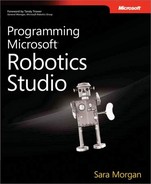When you think of robotics, you typically call to mind images from television or the movies. Depending on your age, you might think of C-3PO or R2-D2 from the famed Star Wars series. Or you might think of the android Data in the Star Trek: The Next Generation television series. More than likely you don’t think of robots assuming a practical or realistic role in your own life—but that may be about to change.
If Bill Gates has anything to say about it, there will be a robot in every home in the not-too-distant future. In an article published in the January 2007 issue of Scientific American, Gates predicts that the robotics industry is about to break open in much the same way the personal computer industry did in the 1980s. Gates writes:
I can envision a future in which robotic devices will become a nearly ubiquitous part of our day-to-day lives. I believe that technologies such as distributed computing, voice and visual recognition, and wireless broadband connectivity will open the door to a new generation of autonomous devices that enable computers to perform tasks in the physical world on our behalf.
In this chapter I’ll give you an overview of the robotics field, covering some of its history and some of its challenges, and I’ll introduce Microsoft Robotics Studio (MSRS), a robotics programming platform developed by Microsoft that will help make Gates’s predictions a reality.
Robotics is a field that has been around for several years. It has long been associated with artificial intelligence, but, for many people, robotics is seen as a practical solution in a world desperate for automation.
For several years, robotics has been widely used by industrial companies to perform jobs that were considered tedious or that were physically beyond the human capabilities. For example, robots have long been used on motor vehicle assembly lines to streamline the manufacturing of new motor vehicles. In the motor vehicle industry, one robot is used for every 10 workers. According to the International Federation of Robotics (http://www.ifr.org), the world market for industrial robots peaked in 2005 with a 30 percent increase over the previous year.
Beyond industrial robots is the newly emerging market of service robots. These robots are available for both personal and professional use. You may already be familiar with the floor-cleaning robot known as Roomba. iRobot (http://www.irobot.com), the maker of the Roomba, manufactures a variety of practical robots that do everything from clean your floors and pools to disable bombs. Roomba sales have already surpassed 2 million units, and you can purchase one in stores across the United States.
Service robots for professional use include those used for underwater exploration, defense and security, construction and demolition, and medical purposes. In the area of robots for personal and domestic use, vacuum and lawn-mowing robots account for the highest-selling products. This number is expected to change as robots are now being built for handicap assistance, personal transportation, and home security. The market for these types of robots is expected to increase significantly over the next few years.
Another quickly emerging market is entertainment robots. This includes not only robots used as toys and companions but also robots used by educators and hobbyists. WowWee (http://www.wowwee.com), maker of the Robosapien, shown in Figure 1-1, offers a line of robotics toys. The Robosapien V2, which claims to be a fusion of personality and technology, comes with a remote control and 100 preprogrammed functions, such as walking, grunting, burping, and dancing. The latest version is even capable of autonomous "free roam" behavior.
Figure 1-1. Robosapien is a popular robotics toy made by WowWee that is capable of autonomous behavior.
According to projections by the International Federation of Robotics, the number of service robots for personal use is expected to reach 5.6 million units for the period 2006 to 2009. The market for these domestic robots will continue to grow, and there will soon be an urgent need for developers with knowledge of robotics programming.
Currently the greatest challenges facing robotics researchers have to do with operating robots in dynamic environments and dealing with an infinite number of possibilities. If you were to break down your movements into a series of specific tasks, the number of tasks would approach hundreds or thousands, depending on the number of obstacles in your room.
For example, to move a robot across a room full of obstacles, the robot must be able to avoid all the obstacles before arriving at the destination. This is hard enough when the obstacles are constant things like chairs and tables, but what if a person steps directly in front of the robots path? To avoid hitting the person, the robot will need to react quickly, and this is not always an easy thing for a robot to do. The robot would need to constantly collect data from its sensors. The data collected from these sensors would be used to indicate whether an object was in the robot’s path. But just collecting the data is not enough. You need to be able to process the sensory data and then instruct the robot to do something, such as turn to the right or stop altogether. As humans, we take this kind of simple decision-making for granted because it comes so naturally to us. But, for robots, these simple things can take an enormous amount of processing power. Each step or movement must be programmed specifically because the robot is not able to think for itself.
Despite the complexity involved with getting a robot to perform human-like tasks, robots can do some things quite easily. Wheeled robots, similar to the Roomba vacuum, can easily navigate a room and avoid obstacles by using a series of sensors. Crawling robots, such as those that mimic insects, are very successful at navigating rough terrain with minimal intelligence. Despite that, challenges remain, and you as a developer can start building useful robotic applications using the resources available today.

